A Detailed Analysis of Marketing Strategies in the FMCG Industry
VerifiedAdded on 2020/03/04
|10
|1658
|406
Report
AI Summary
This report provides a comparative analysis of the marketing strategies employed by Billabong, Nestle, Unilever, and Coca-Cola. It begins with an executive summary and table of contents, followed by an introduction that outlines the report's objectives. The report then delves into the background and product descriptions of each company, including Billabong's online presence and product offerings, as well as Nestle, Unilever, and Coca-Cola's diverse FMCG product portfolios. The core of the report examines the unique marketing strategies of each company, such as Billabong's online-focused approach, Nestle's transnational and localization strategies, Unilever's focus on product validity and customer satisfaction, and Coca-Cola's segmentation, targeting, and positioning strategies. The report concludes by summarizing the key findings and highlighting the distinct marketing approaches that contribute to each company's success. References to academic sources are included to support the analysis.
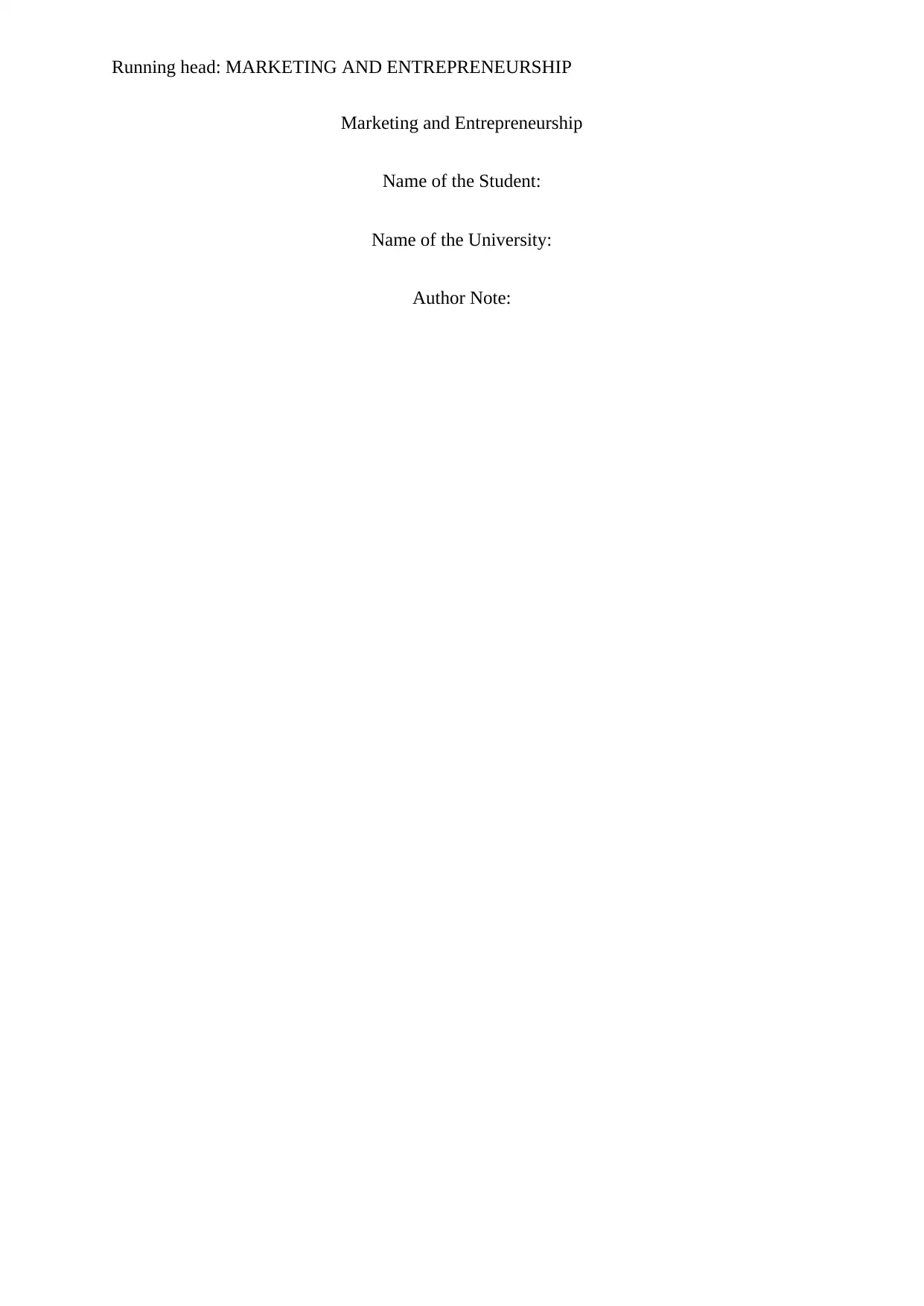
Running head: MARKETING AND ENTREPRENEURSHIP
Marketing and Entrepreneurship
Name of the Student:
Name of the University:
Author Note:
Marketing and Entrepreneurship
Name of the Student:
Name of the University:
Author Note:
Paraphrase This Document
Need a fresh take? Get an instant paraphrase of this document with our AI Paraphraser

1MARKETING AND ENTREPRENEURSHIP
Executive Summary:
The report presents a discussion on the background and product description of an online
company Billabong and FMCG (Fast Manufacturing Consumer Goods) Goods Companies
like Unilever, Nestle, and Coca Cola. In the report there is also a vivid description of the
marketing strategies adopted by each company that enables one to understand the reason
behind their competitive edge. Through the report one can get a clear picture about the
unique marketing style of each of the companies that is the sole reason behind their success.
Executive Summary:
The report presents a discussion on the background and product description of an online
company Billabong and FMCG (Fast Manufacturing Consumer Goods) Goods Companies
like Unilever, Nestle, and Coca Cola. In the report there is also a vivid description of the
marketing strategies adopted by each company that enables one to understand the reason
behind their competitive edge. Through the report one can get a clear picture about the
unique marketing style of each of the companies that is the sole reason behind their success.
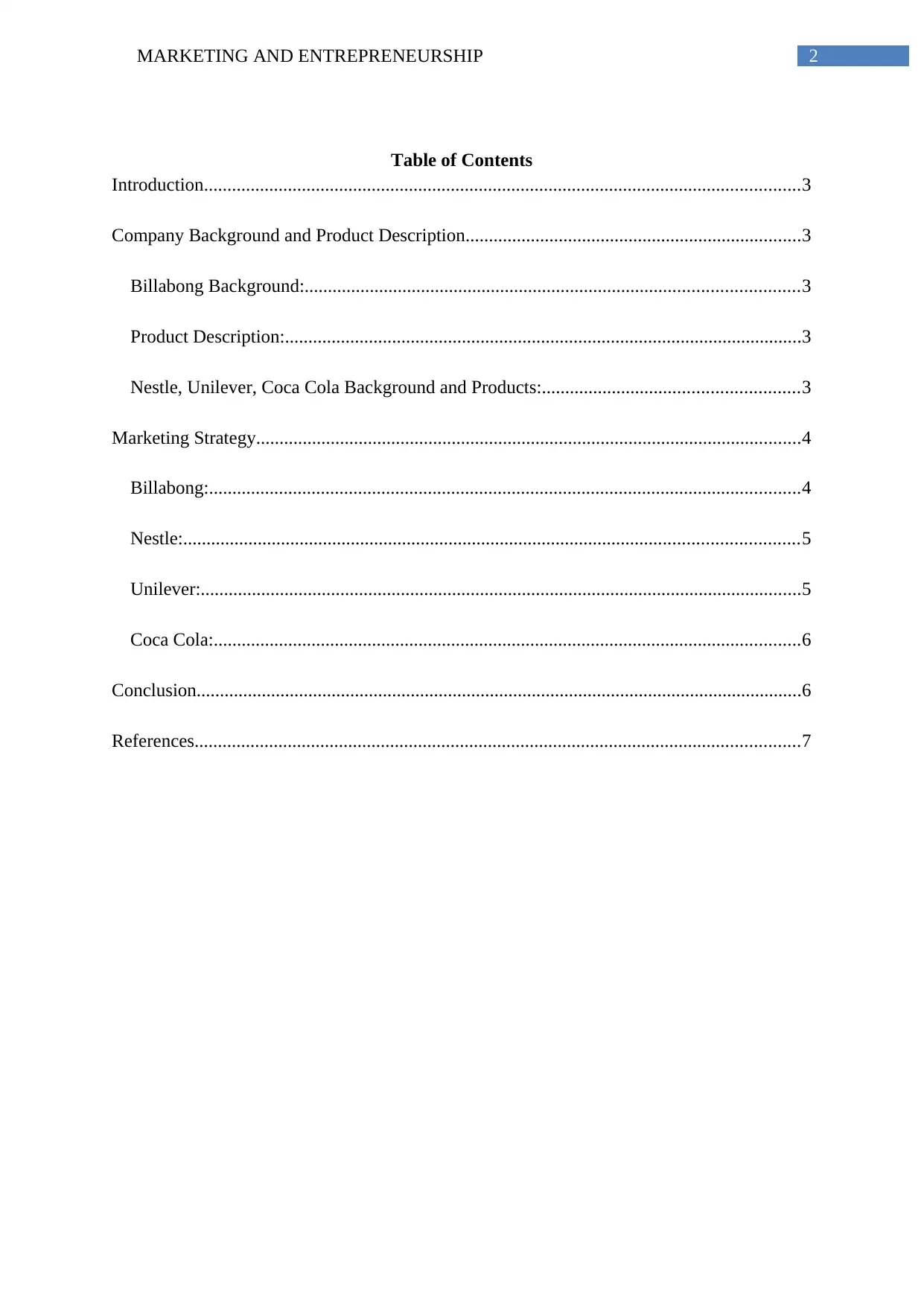
2MARKETING AND ENTREPRENEURSHIP
Table of Contents
Introduction................................................................................................................................3
Company Background and Product Description........................................................................3
Billabong Background:..........................................................................................................3
Product Description:...............................................................................................................3
Nestle, Unilever, Coca Cola Background and Products:.......................................................3
Marketing Strategy.....................................................................................................................4
Billabong:...............................................................................................................................4
Nestle:....................................................................................................................................5
Unilever:.................................................................................................................................5
Coca Cola:..............................................................................................................................6
Conclusion..................................................................................................................................6
References..................................................................................................................................7
Table of Contents
Introduction................................................................................................................................3
Company Background and Product Description........................................................................3
Billabong Background:..........................................................................................................3
Product Description:...............................................................................................................3
Nestle, Unilever, Coca Cola Background and Products:.......................................................3
Marketing Strategy.....................................................................................................................4
Billabong:...............................................................................................................................4
Nestle:....................................................................................................................................5
Unilever:.................................................................................................................................5
Coca Cola:..............................................................................................................................6
Conclusion..................................................................................................................................6
References..................................................................................................................................7
⊘ This is a preview!⊘
Do you want full access?
Subscribe today to unlock all pages.

Trusted by 1+ million students worldwide
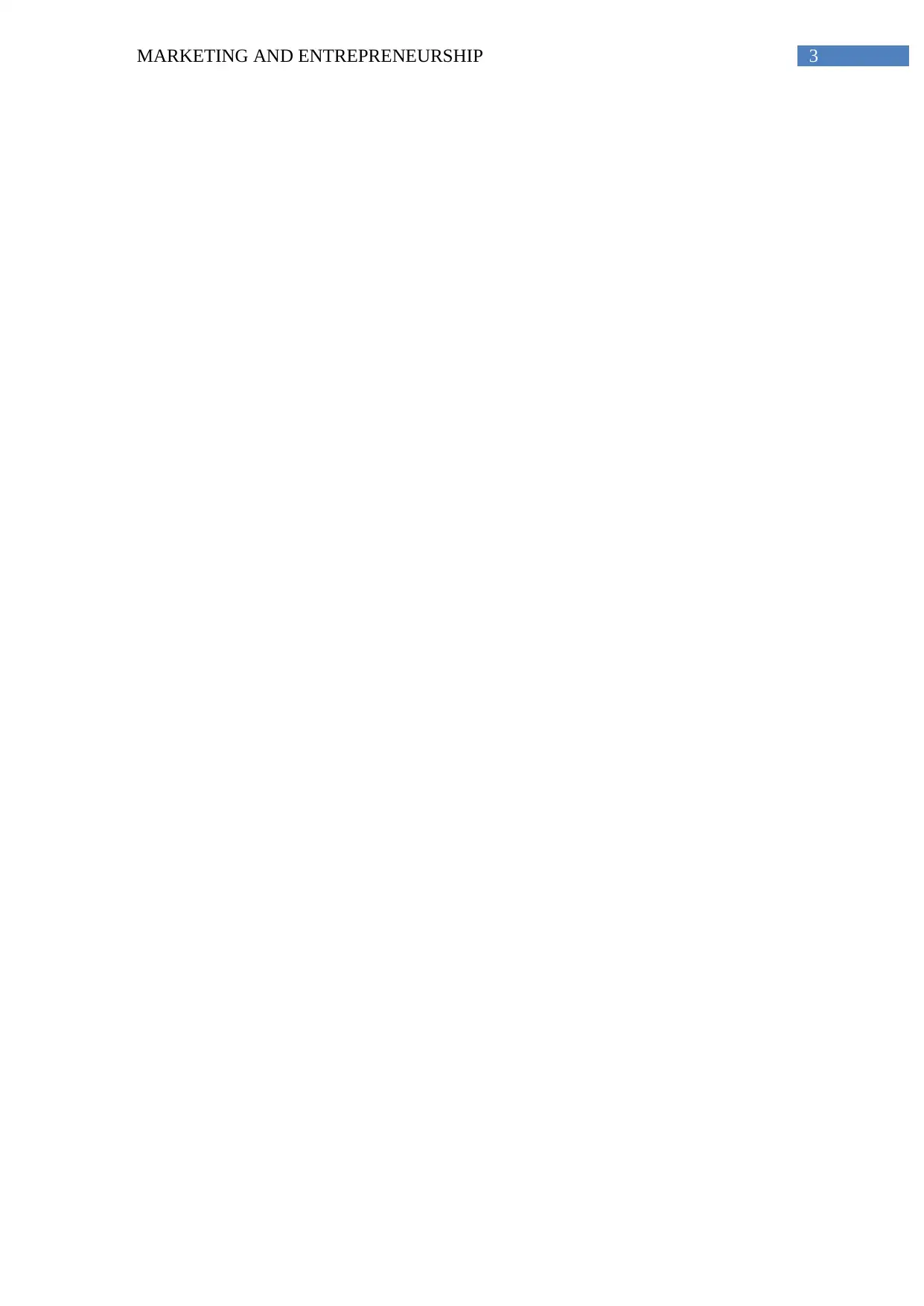
3MARKETING AND ENTREPRENEURSHIP
Paraphrase This Document
Need a fresh take? Get an instant paraphrase of this document with our AI Paraphraser
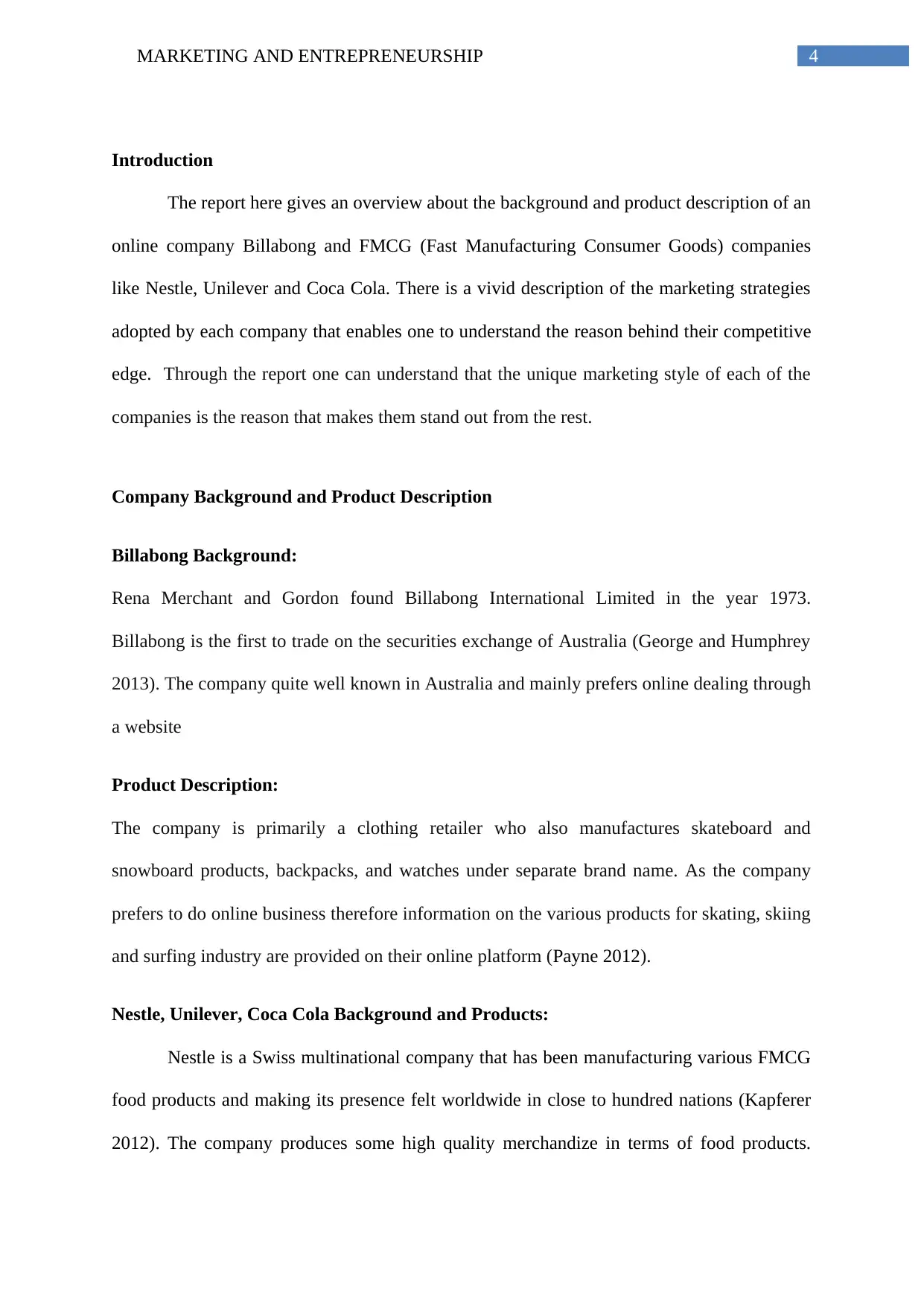
4MARKETING AND ENTREPRENEURSHIP
Introduction
The report here gives an overview about the background and product description of an
online company Billabong and FMCG (Fast Manufacturing Consumer Goods) companies
like Nestle, Unilever and Coca Cola. There is a vivid description of the marketing strategies
adopted by each company that enables one to understand the reason behind their competitive
edge. Through the report one can understand that the unique marketing style of each of the
companies is the reason that makes them stand out from the rest.
Company Background and Product Description
Billabong Background:
Rena Merchant and Gordon found Billabong International Limited in the year 1973.
Billabong is the first to trade on the securities exchange of Australia (George and Humphrey
2013). The company quite well known in Australia and mainly prefers online dealing through
a website
Product Description:
The company is primarily a clothing retailer who also manufactures skateboard and
snowboard products, backpacks, and watches under separate brand name. As the company
prefers to do online business therefore information on the various products for skating, skiing
and surfing industry are provided on their online platform (Payne 2012).
Nestle, Unilever, Coca Cola Background and Products:
Nestle is a Swiss multinational company that has been manufacturing various FMCG
food products and making its presence felt worldwide in close to hundred nations (Kapferer
2012). The company produces some high quality merchandize in terms of food products.
Introduction
The report here gives an overview about the background and product description of an
online company Billabong and FMCG (Fast Manufacturing Consumer Goods) companies
like Nestle, Unilever and Coca Cola. There is a vivid description of the marketing strategies
adopted by each company that enables one to understand the reason behind their competitive
edge. Through the report one can understand that the unique marketing style of each of the
companies is the reason that makes them stand out from the rest.
Company Background and Product Description
Billabong Background:
Rena Merchant and Gordon found Billabong International Limited in the year 1973.
Billabong is the first to trade on the securities exchange of Australia (George and Humphrey
2013). The company quite well known in Australia and mainly prefers online dealing through
a website
Product Description:
The company is primarily a clothing retailer who also manufactures skateboard and
snowboard products, backpacks, and watches under separate brand name. As the company
prefers to do online business therefore information on the various products for skating, skiing
and surfing industry are provided on their online platform (Payne 2012).
Nestle, Unilever, Coca Cola Background and Products:
Nestle is a Swiss multinational company that has been manufacturing various FMCG
food products and making its presence felt worldwide in close to hundred nations (Kapferer
2012). The company produces some high quality merchandize in terms of food products.
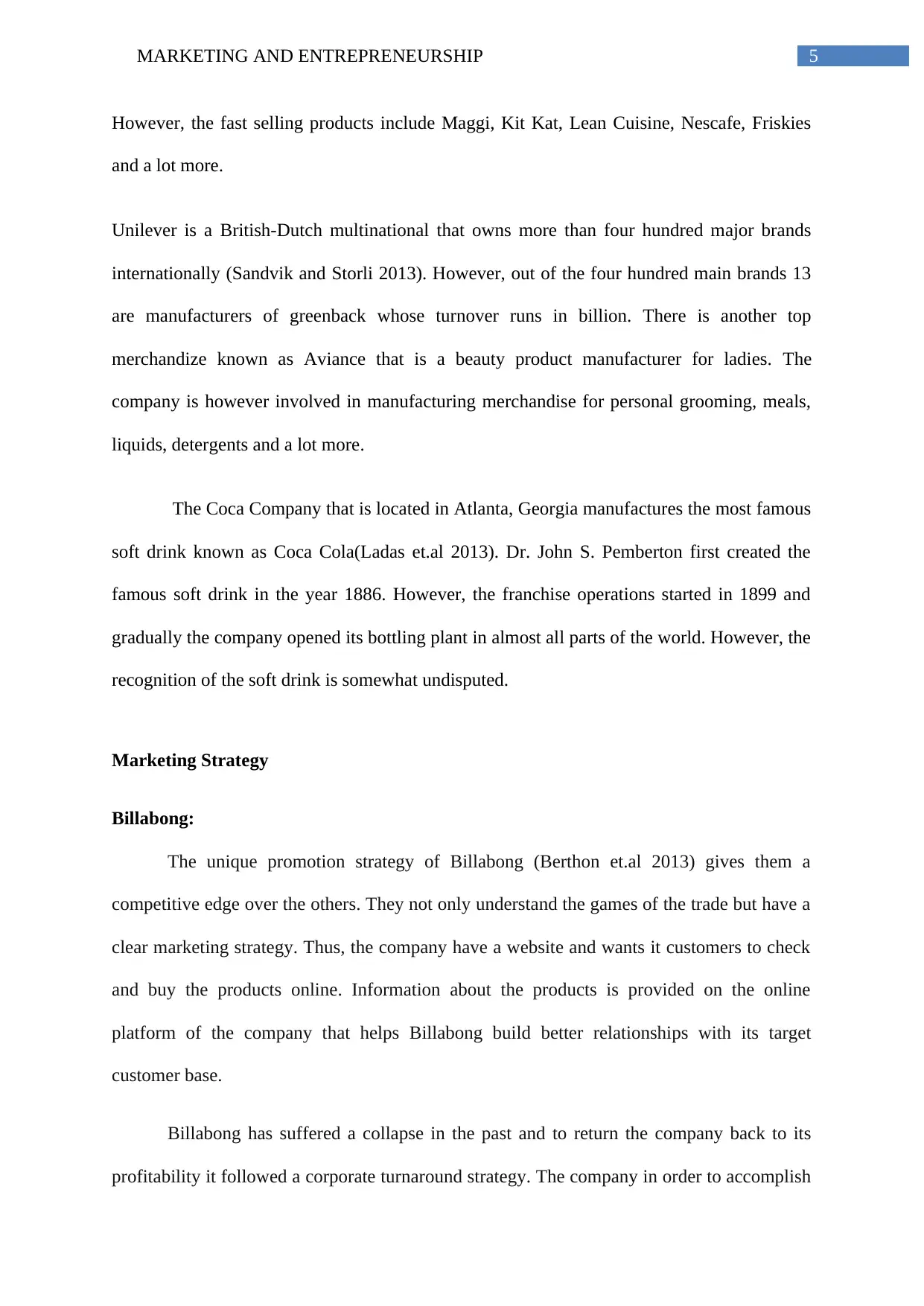
5MARKETING AND ENTREPRENEURSHIP
However, the fast selling products include Maggi, Kit Kat, Lean Cuisine, Nescafe, Friskies
and a lot more.
Unilever is a British-Dutch multinational that owns more than four hundred major brands
internationally (Sandvik and Storli 2013). However, out of the four hundred main brands 13
are manufacturers of greenback whose turnover runs in billion. There is another top
merchandize known as Aviance that is a beauty product manufacturer for ladies. The
company is however involved in manufacturing merchandise for personal grooming, meals,
liquids, detergents and a lot more.
The Coca Company that is located in Atlanta, Georgia manufactures the most famous
soft drink known as Coca Cola(Ladas et.al 2013). Dr. John S. Pemberton first created the
famous soft drink in the year 1886. However, the franchise operations started in 1899 and
gradually the company opened its bottling plant in almost all parts of the world. However, the
recognition of the soft drink is somewhat undisputed.
Marketing Strategy
Billabong:
The unique promotion strategy of Billabong (Berthon et.al 2013) gives them a
competitive edge over the others. They not only understand the games of the trade but have a
clear marketing strategy. Thus, the company have a website and wants it customers to check
and buy the products online. Information about the products is provided on the online
platform of the company that helps Billabong build better relationships with its target
customer base.
Billabong has suffered a collapse in the past and to return the company back to its
profitability it followed a corporate turnaround strategy. The company in order to accomplish
However, the fast selling products include Maggi, Kit Kat, Lean Cuisine, Nescafe, Friskies
and a lot more.
Unilever is a British-Dutch multinational that owns more than four hundred major brands
internationally (Sandvik and Storli 2013). However, out of the four hundred main brands 13
are manufacturers of greenback whose turnover runs in billion. There is another top
merchandize known as Aviance that is a beauty product manufacturer for ladies. The
company is however involved in manufacturing merchandise for personal grooming, meals,
liquids, detergents and a lot more.
The Coca Company that is located in Atlanta, Georgia manufactures the most famous
soft drink known as Coca Cola(Ladas et.al 2013). Dr. John S. Pemberton first created the
famous soft drink in the year 1886. However, the franchise operations started in 1899 and
gradually the company opened its bottling plant in almost all parts of the world. However, the
recognition of the soft drink is somewhat undisputed.
Marketing Strategy
Billabong:
The unique promotion strategy of Billabong (Berthon et.al 2013) gives them a
competitive edge over the others. They not only understand the games of the trade but have a
clear marketing strategy. Thus, the company have a website and wants it customers to check
and buy the products online. Information about the products is provided on the online
platform of the company that helps Billabong build better relationships with its target
customer base.
Billabong has suffered a collapse in the past and to return the company back to its
profitability it followed a corporate turnaround strategy. The company in order to accomplish
⊘ This is a preview!⊘
Do you want full access?
Subscribe today to unlock all pages.

Trusted by 1+ million students worldwide
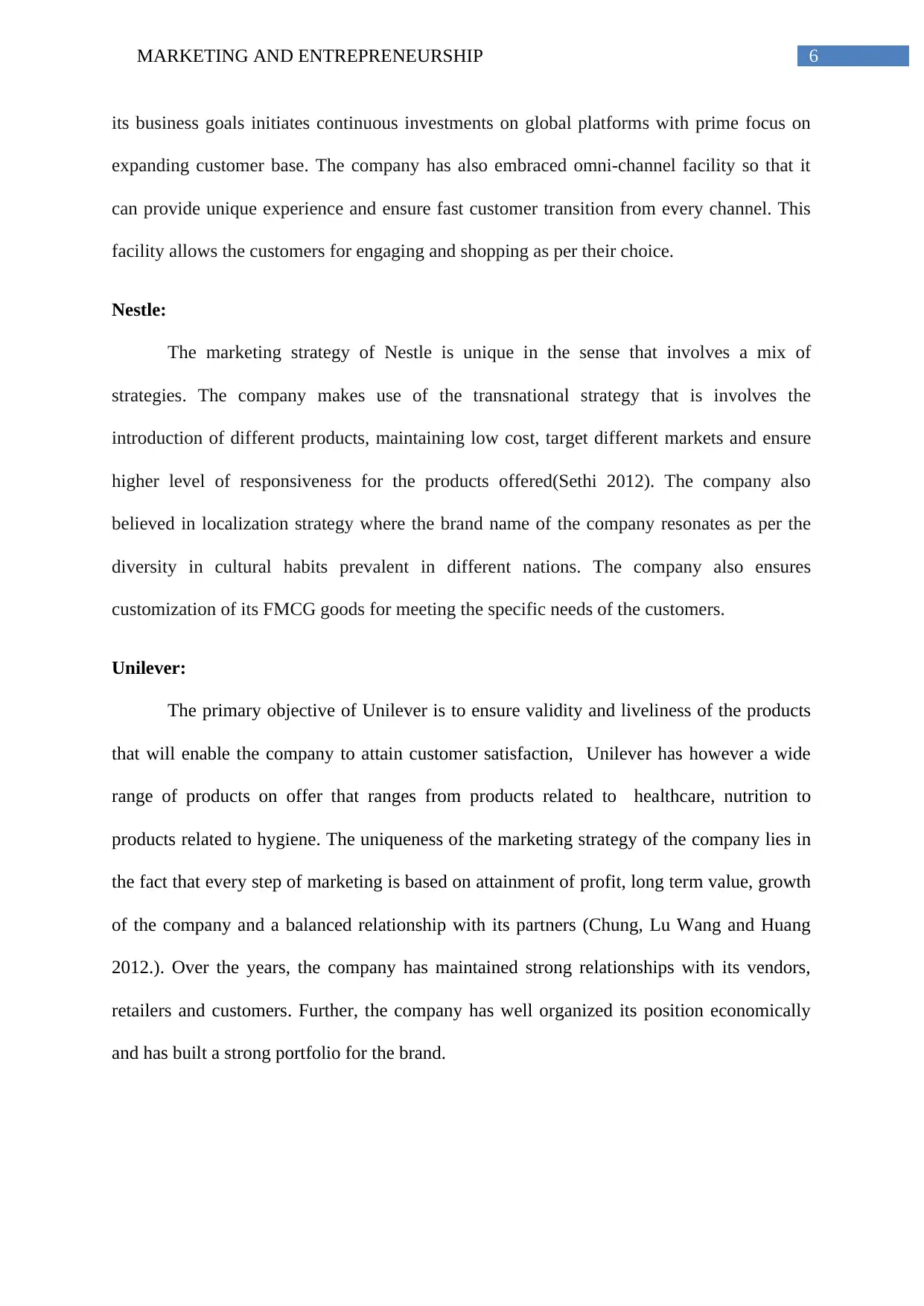
6MARKETING AND ENTREPRENEURSHIP
its business goals initiates continuous investments on global platforms with prime focus on
expanding customer base. The company has also embraced omni-channel facility so that it
can provide unique experience and ensure fast customer transition from every channel. This
facility allows the customers for engaging and shopping as per their choice.
Nestle:
The marketing strategy of Nestle is unique in the sense that involves a mix of
strategies. The company makes use of the transnational strategy that is involves the
introduction of different products, maintaining low cost, target different markets and ensure
higher level of responsiveness for the products offered(Sethi 2012). The company also
believed in localization strategy where the brand name of the company resonates as per the
diversity in cultural habits prevalent in different nations. The company also ensures
customization of its FMCG goods for meeting the specific needs of the customers.
Unilever:
The primary objective of Unilever is to ensure validity and liveliness of the products
that will enable the company to attain customer satisfaction, Unilever has however a wide
range of products on offer that ranges from products related to healthcare, nutrition to
products related to hygiene. The uniqueness of the marketing strategy of the company lies in
the fact that every step of marketing is based on attainment of profit, long term value, growth
of the company and a balanced relationship with its partners (Chung, Lu Wang and Huang
2012.). Over the years, the company has maintained strong relationships with its vendors,
retailers and customers. Further, the company has well organized its position economically
and has built a strong portfolio for the brand.
its business goals initiates continuous investments on global platforms with prime focus on
expanding customer base. The company has also embraced omni-channel facility so that it
can provide unique experience and ensure fast customer transition from every channel. This
facility allows the customers for engaging and shopping as per their choice.
Nestle:
The marketing strategy of Nestle is unique in the sense that involves a mix of
strategies. The company makes use of the transnational strategy that is involves the
introduction of different products, maintaining low cost, target different markets and ensure
higher level of responsiveness for the products offered(Sethi 2012). The company also
believed in localization strategy where the brand name of the company resonates as per the
diversity in cultural habits prevalent in different nations. The company also ensures
customization of its FMCG goods for meeting the specific needs of the customers.
Unilever:
The primary objective of Unilever is to ensure validity and liveliness of the products
that will enable the company to attain customer satisfaction, Unilever has however a wide
range of products on offer that ranges from products related to healthcare, nutrition to
products related to hygiene. The uniqueness of the marketing strategy of the company lies in
the fact that every step of marketing is based on attainment of profit, long term value, growth
of the company and a balanced relationship with its partners (Chung, Lu Wang and Huang
2012.). Over the years, the company has maintained strong relationships with its vendors,
retailers and customers. Further, the company has well organized its position economically
and has built a strong portfolio for the brand.
Paraphrase This Document
Need a fresh take? Get an instant paraphrase of this document with our AI Paraphraser

7MARKETING AND ENTREPRENEURSHIP
Coca Cola:
Considered as the leading soft drink maker of the world, the company has an
operation in more than 200 countries worldwide. The brand recognition of the company is
very strong that accounts for 60% of its revenue generation. The marketing strategy of
company lies in segmentation, targeting and positioning of the soft drink brand. Through
segmentation the brand is able to define suitable products for a customer group that is
specific. However, the company does not target a particular segment but attempts to adapt the
marketing strategy through the development of newer products. The company also uses a mix
of undifferentiated strategies for mass marketing and follows niche marketing for some
products for increasing and driving sales in the competitive market. For instance, though
Coca Cola has popularity worldwide and is quite preferred by people of all age groups but the
company’s diet coke range is targeted to a particular segment of health conscious people. The
company also makes use of the strategy of competitive positioning to hold a position far
ahead of its competitors in the beverage market.
Conclusion
The report ends with a discussion on the marketing strategies of the various FMCG
companies like Nestle, Unilever and Coca Cola. The report also shows that how each of the
companies is using a marketing strategy to capture their position in the market. Thus, the
report shows that each one of the company has their own unique marketing style that makes
them stand out on their own way. The report also discusses about the company background of
Billabong, Nestle, Unilever and Coca Cola along with a vivid description of their products.
There is a vivid description of not only the companies but their products as well.
Coca Cola:
Considered as the leading soft drink maker of the world, the company has an
operation in more than 200 countries worldwide. The brand recognition of the company is
very strong that accounts for 60% of its revenue generation. The marketing strategy of
company lies in segmentation, targeting and positioning of the soft drink brand. Through
segmentation the brand is able to define suitable products for a customer group that is
specific. However, the company does not target a particular segment but attempts to adapt the
marketing strategy through the development of newer products. The company also uses a mix
of undifferentiated strategies for mass marketing and follows niche marketing for some
products for increasing and driving sales in the competitive market. For instance, though
Coca Cola has popularity worldwide and is quite preferred by people of all age groups but the
company’s diet coke range is targeted to a particular segment of health conscious people. The
company also makes use of the strategy of competitive positioning to hold a position far
ahead of its competitors in the beverage market.
Conclusion
The report ends with a discussion on the marketing strategies of the various FMCG
companies like Nestle, Unilever and Coca Cola. The report also shows that how each of the
companies is using a marketing strategy to capture their position in the market. Thus, the
report shows that each one of the company has their own unique marketing style that makes
them stand out on their own way. The report also discusses about the company background of
Billabong, Nestle, Unilever and Coca Cola along with a vivid description of their products.
There is a vivid description of not only the companies but their products as well.
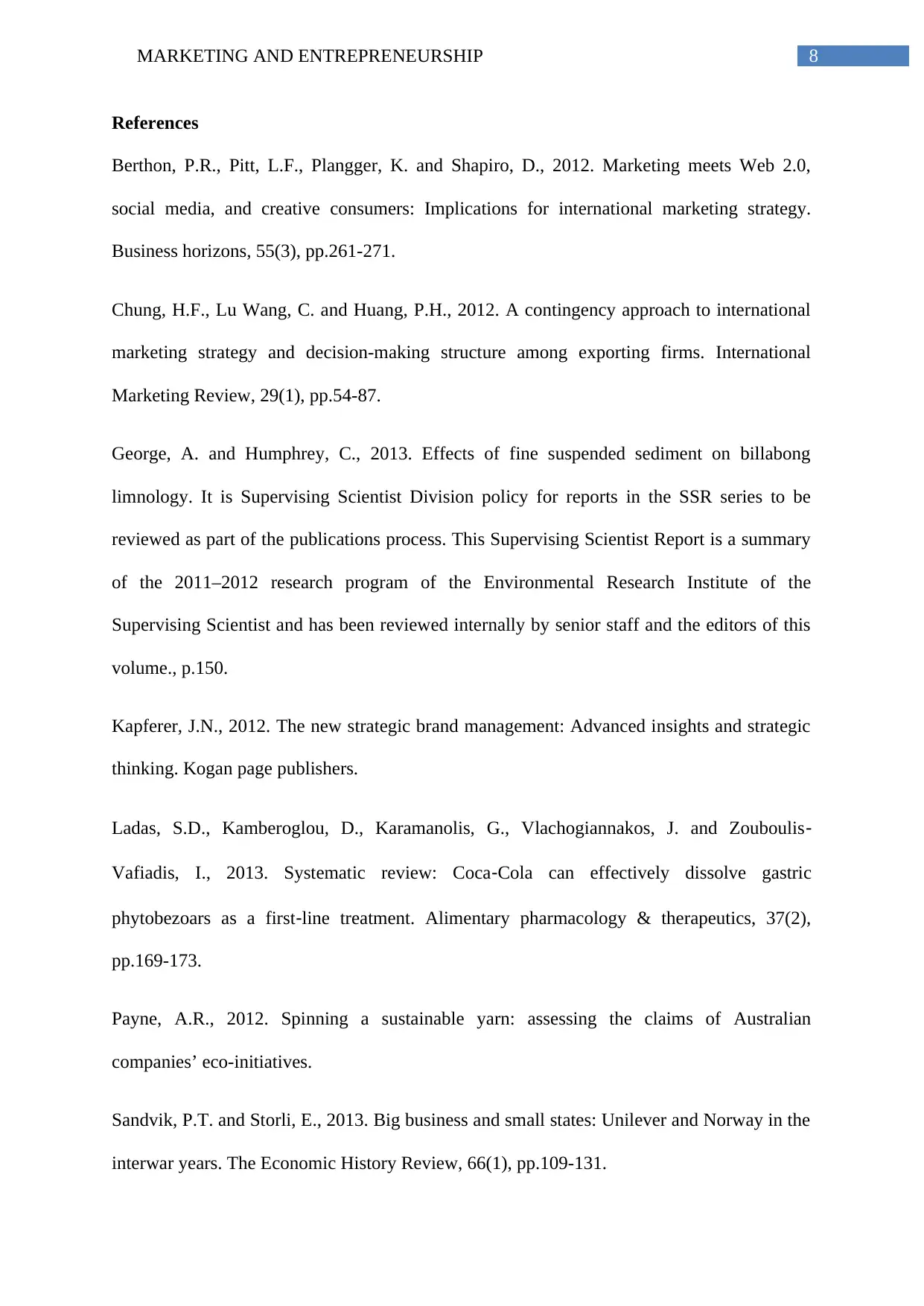
8MARKETING AND ENTREPRENEURSHIP
References
Berthon, P.R., Pitt, L.F., Plangger, K. and Shapiro, D., 2012. Marketing meets Web 2.0,
social media, and creative consumers: Implications for international marketing strategy.
Business horizons, 55(3), pp.261-271.
Chung, H.F., Lu Wang, C. and Huang, P.H., 2012. A contingency approach to international
marketing strategy and decision-making structure among exporting firms. International
Marketing Review, 29(1), pp.54-87.
George, A. and Humphrey, C., 2013. Effects of fine suspended sediment on billabong
limnology. It is Supervising Scientist Division policy for reports in the SSR series to be
reviewed as part of the publications process. This Supervising Scientist Report is a summary
of the 2011–2012 research program of the Environmental Research Institute of the
Supervising Scientist and has been reviewed internally by senior staff and the editors of this
volume., p.150.
Kapferer, J.N., 2012. The new strategic brand management: Advanced insights and strategic
thinking. Kogan page publishers.
Ladas, S.D., Kamberoglou, D., Karamanolis, G., Vlachogiannakos, J. and Zouboulis‐
Vafiadis, I., 2013. Systematic review: Coca‐Cola can effectively dissolve gastric
phytobezoars as a first‐line treatment. Alimentary pharmacology & therapeutics, 37(2),
pp.169-173.
Payne, A.R., 2012. Spinning a sustainable yarn: assessing the claims of Australian
companies’ eco-initiatives.
Sandvik, P.T. and Storli, E., 2013. Big business and small states: Unilever and Norway in the
interwar years. The Economic History Review, 66(1), pp.109-131.
References
Berthon, P.R., Pitt, L.F., Plangger, K. and Shapiro, D., 2012. Marketing meets Web 2.0,
social media, and creative consumers: Implications for international marketing strategy.
Business horizons, 55(3), pp.261-271.
Chung, H.F., Lu Wang, C. and Huang, P.H., 2012. A contingency approach to international
marketing strategy and decision-making structure among exporting firms. International
Marketing Review, 29(1), pp.54-87.
George, A. and Humphrey, C., 2013. Effects of fine suspended sediment on billabong
limnology. It is Supervising Scientist Division policy for reports in the SSR series to be
reviewed as part of the publications process. This Supervising Scientist Report is a summary
of the 2011–2012 research program of the Environmental Research Institute of the
Supervising Scientist and has been reviewed internally by senior staff and the editors of this
volume., p.150.
Kapferer, J.N., 2012. The new strategic brand management: Advanced insights and strategic
thinking. Kogan page publishers.
Ladas, S.D., Kamberoglou, D., Karamanolis, G., Vlachogiannakos, J. and Zouboulis‐
Vafiadis, I., 2013. Systematic review: Coca‐Cola can effectively dissolve gastric
phytobezoars as a first‐line treatment. Alimentary pharmacology & therapeutics, 37(2),
pp.169-173.
Payne, A.R., 2012. Spinning a sustainable yarn: assessing the claims of Australian
companies’ eco-initiatives.
Sandvik, P.T. and Storli, E., 2013. Big business and small states: Unilever and Norway in the
interwar years. The Economic History Review, 66(1), pp.109-131.
⊘ This is a preview!⊘
Do you want full access?
Subscribe today to unlock all pages.

Trusted by 1+ million students worldwide

9MARKETING AND ENTREPRENEURSHIP
Sethi, S.P., 2012. Multinational corporations and the impact of public advocacy on corporate
strategy: Nestle and the infant formula controversy (Vol. 6). Springer Science & Business
Media.
Sethi, S.P., 2012. Multinational corporations and the impact of public advocacy on corporate
strategy: Nestle and the infant formula controversy (Vol. 6). Springer Science & Business
Media.
1 out of 10
Related Documents
Your All-in-One AI-Powered Toolkit for Academic Success.
+13062052269
info@desklib.com
Available 24*7 on WhatsApp / Email
![[object Object]](/_next/static/media/star-bottom.7253800d.svg)
Unlock your academic potential
Copyright © 2020–2025 A2Z Services. All Rights Reserved. Developed and managed by ZUCOL.



